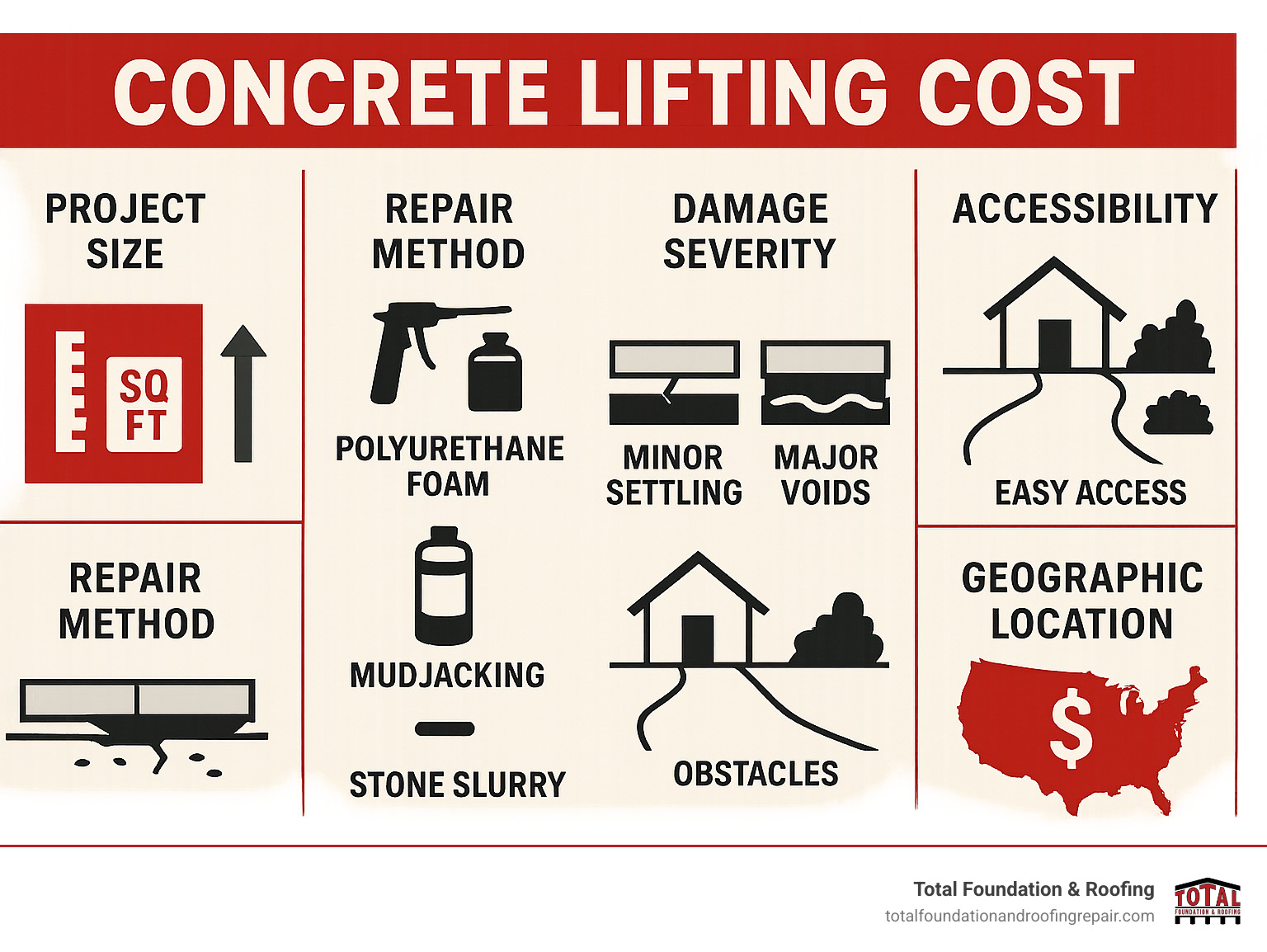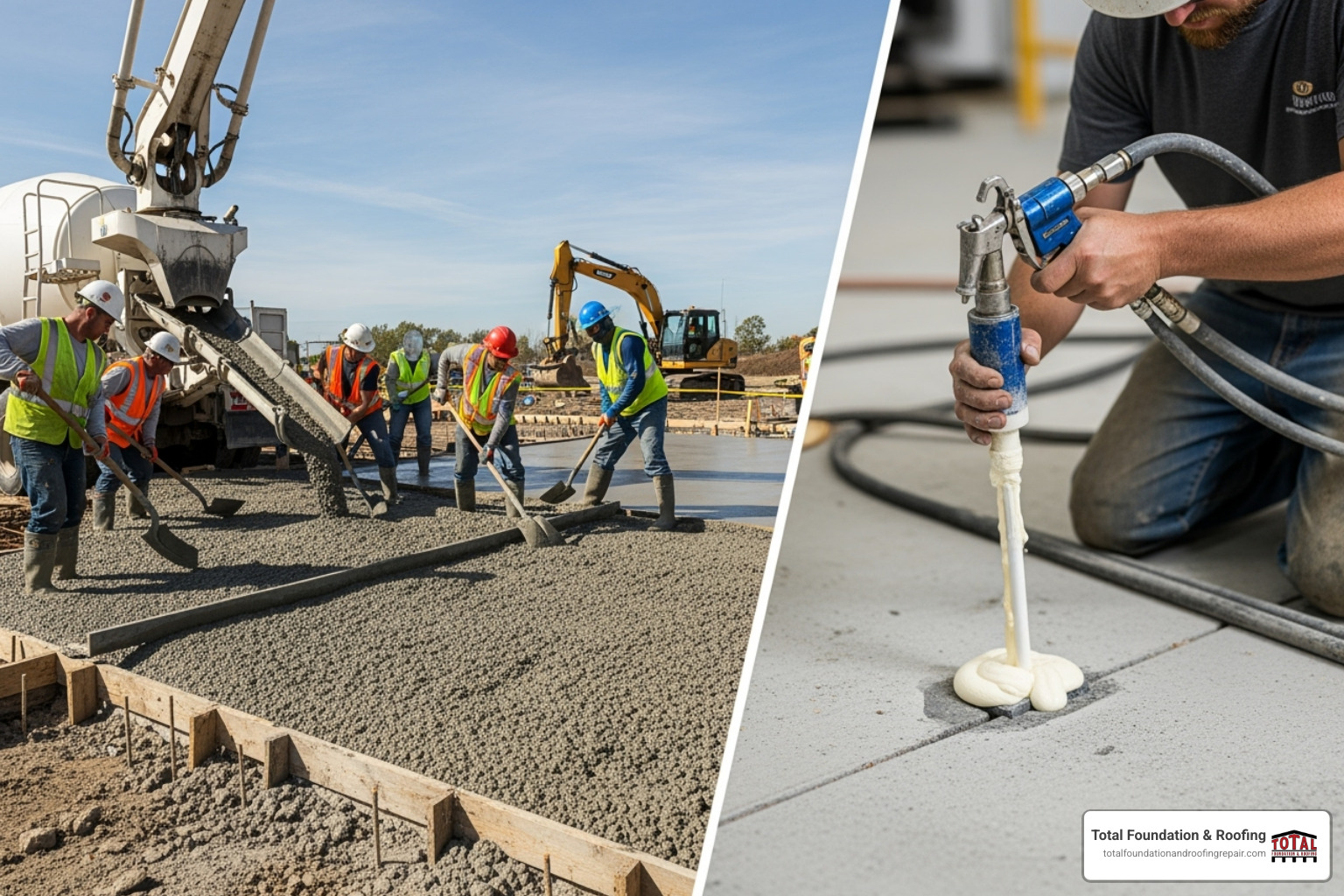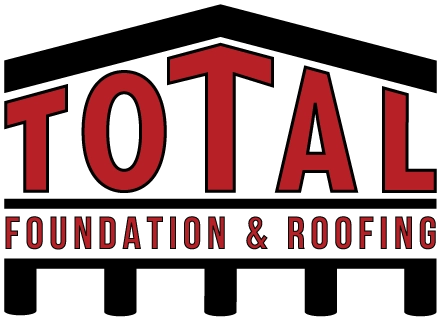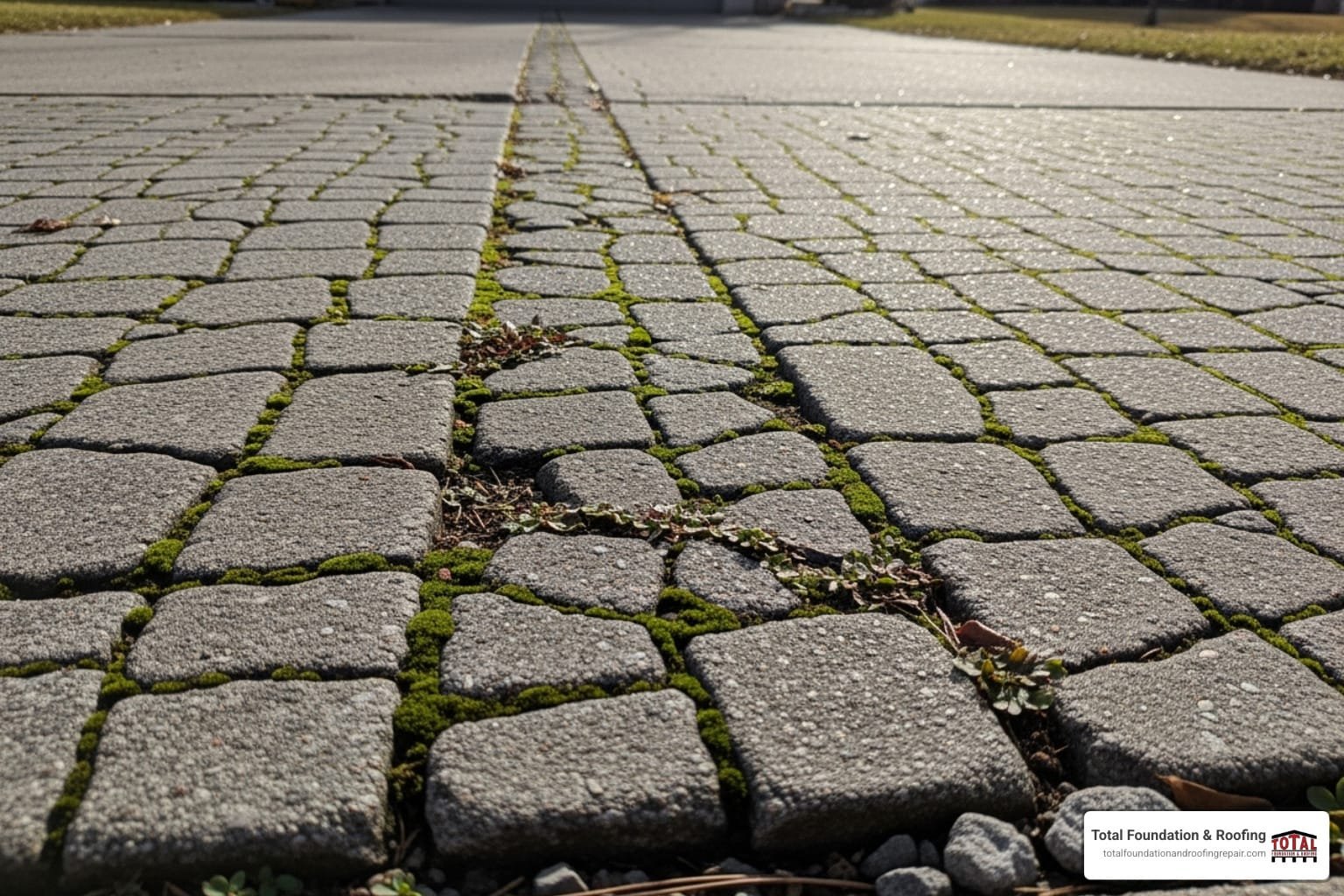Table of Contents
ToggleWhy Understanding Concrete Lifting Cost Matters for Texas Homeowners
The concrete lifting cost for your project will vary, but most Texas homeowners can expect to pay between $500 and $4,000. When you notice a sinking driveway or an uneven sidewalk creating a trip hazard, you’re facing a common issue in the Texas Hill Country. Thankfully, you don’t have to tear it all out. As your trusted foundation and roofing experts, the team at Total Foundation & Roofing Repair uses modern concrete lifting to deliver a lasting fix for a fraction of the replacement cost. We provide expert concrete services that address the unique challenges of our local soil.
Quick Cost Overview:
- Polyurethane Foam Lifting: $5-$25 per square foot
- Traditional Mudjacking: $3-$8 per square foot
- Typical Project Ranges: $500-$4,000 for most residential repairs
- Minimum Trip Fees: $300-$2,000 depending on contractor
- Cost vs. Replacement: 50-80% cheaper than pouring new concrete
Expansive clay soils and extreme weather cycles cause concrete slabs to settle and crack over time. The good news is that you don’t need to tear out and replace that concrete. Modern concrete lifting techniques can restore your surfaces for a fraction of the replacement cost, often in just a few hours.
Two main methods dominate the industry: polyurethane foam injection (polyjacking) and traditional mudjacking. Each has different cost structures and applications. Understanding these differences helps you make the right choice for your property and budget.

What is Concrete Lifting and What Are The Common Methods?
Concrete lifting (also called slab jacking) is a process that raises sunken concrete back to its original position. Instead of the expense of tearing out and replacing entire slabs, we inject specialized materials underneath to fill voids and gently lift the concrete. This problem is common in the Texas Hill Country because our expansive clay soils shift with weather changes, creating empty spaces under the concrete. When that support disappears, the slabs sink. Our Concrete Leveling Services are designed to fix these issues quickly and affordably.

There are three main methods for concrete lifting, each suited for different situations and budgets.
Polyurethane Foam Lifting (Polyjacking)
Polyurethane foam lifting is a modern, high-tech solution. We drill tiny small injection holes (about the size of a penny) and inject a two-part high-density foam that expands to fill voids and lift your concrete.
This lightweight material weighs only 4-6 pounds per cubic foot, compared to 100-150 pounds for traditional methods. This means less stress on unstable soil, reducing the chance of future settling. The quick cure time is a major benefit; your concrete is typically ready for traffic within 15-30 minutes. The foam is also water-resistant and won’t wash away.
This durable solution typically costs between $5-$25 per square foot. While it may cost more upfront than mudjacking, its longevity often makes it a smarter investment. For more technical details, see our guide on Concrete Slab Lifting Equipment.
Traditional Mudjacking (Slabjacking)
Traditional mudjacking is a proven method that has been used for decades. This technique involves drilling larger injection holes (an inch or more) and pumping a cement slurry mixture of soil, sand, and cement under the slab.
The heavier material adds more weight to the soil, which can sometimes lead to future settlement if underlying soil issues aren’t addressed. The larger injection holes are also more noticeable, though they are patched after the job. You’ll need to plan for a slower cure time of 24-48 hours before driving on the surface. The main advantage is that it’s the most cost-effective option upfront, usually running $3-$8 per square foot.
Stone Slurry Grout Leveling
Stone slurry grout leveling uses pulverized limestone mixed with water to create a natural lifting solution that fills voids completely. This hybrid method offers excellent controlled lift capabilities, as the fine limestone particles flow into tiny spaces for solid support. It bridges the gap between mudjacking and polyjacking, typically costing $7-$25 per square foot.
The Real Concrete Lifting Cost: A Detailed Breakdown
Calculating concrete lifting cost isn’t as simple as multiplying square footage by a set price. The final cost is more nuanced, depending on several key factors that can only be assessed on-site. Understanding these variables helps you make an informed decision and get the best value.
Project size is about more than surface area. A 100-square-foot section that has settled six inches requires significantly more material than one that has only dropped two inches. We are filling underground voids, which vary dramatically in size.
Accessibility also plays a role. If our equipment can’t get close to the problem area, we may need to run extra hoses, which adds time and complexity to the job.
Geographic location affects pricing due to local soil conditions and overhead costs. In the Texas Hill Country, our expertise with local soil is crucial, and we benefit from lower overhead than in major metro areas.
Minimum trip fees are a standard part of pricing, typically ranging from $300 to $2,000. These fees cover the fixed costs of mobilizing specialized equipment and skilled technicians, regardless of the project’s size.
| Feature | Polyurethane Foam Lifting (Polyjacking) | Traditional Mudjacking (Slabjacking) |
|---|---|---|
| Cost (per sq ft) | $5 – $25 | $3 – $8 |
| Hole Size | Penny-sized (5/8 inch) | Larger (1 inch+) |
| Material Weight | Very lightweight (4-6 lbs/cu ft) | Heavy (100-150 lbs/cu ft) |
| Cure Time | 15-30 minutes | 24-48 hours |
| Best Use Cases | Driveways, patios, pool decks, foundations (where soil stability is crucial) | Sidewalks, smaller slabs, non-critical areas (where budget is primary concern) |
Average Concrete Lifting Cost by Method
Polyurethane foam lifting typically runs $5 to $25 per square foot. The material itself costs more, and the specialized equipment is a significant investment. Most polyjacking projects fall between $1,000 and $3,000.
Traditional mudjacking comes in at $3 to $8 per square foot, making it about 20% cheaper than foam initially. The materials are less expensive, and the technique is well-established. Typical projects range from $600 to $2,500.
Stone slurry grout leveling sits in the middle at $7 to $25 per square foot. This method combines benefits of both approaches but isn’t always the best choice for every situation.
Material costs are only part of the equation. Labor rates for skilled technicians who can precisely control the lift make up a significant portion of the bill. That expertise is worth paying for to prevent cracks or over-lifting.
Typical Concrete Lifting Cost for Common Projects
Here are real-world cost ranges for projects we see in the Texas Hill Country.
- Driveway leveling: $800 – $4,000. Fixing a few sections usually costs $800 to $1,200, while larger jobs offer better per-section value.
- Patio repair: $850 – $3,500. A common repair of a few sections along a house often falls in the $850 to $1,200 range.
- Sidewalk leveling: $500 – $2,500. A single section might be $250 to $450, but costs per section decrease with larger projects.
- Garage floor lifting: $900 – $4,500. Costs are similar to driveways, but enclosed spaces can sometimes increase complexity.
- Pool deck repair: $1,500 – $5,000. This requires extra precision to protect the pool’s structure and drainage.
- Steps and porches: $990 – $6,000+. Simple steps are straightforward, but raised porches may require more complex structural work.
These are typical ranges. Your specific concrete lifting cost will depend on the unique conditions at your property.
Concrete Lifting vs. Replacement: Which is More Cost-Effective?
When facing sunken concrete, the choice between repair and replacement is clear: the concrete lifting cost almost always makes lifting the smarter, more cost-effective option. Lifting typically saves you 50% to 85% compared to a full replacement. A $4,000 driveway replacement might only cost $800 to $2,000 to lift and level instead.

Beyond the monetary savings, consider the time and disruption. Concrete lifting is incredibly fast. With polyurethane foam, you can often use the surface within 30 minutes. Replacement involves days or weeks of demolition, removal, pouring, and curing. Your property becomes a construction zone for weeks instead of hours.
Lifting is also the greener choice. It reuses your existing concrete, which dramatically reduces material waste and the carbon footprint associated with producing and hauling new concrete. For perspective on replacement costs, you can check typical cost of replacement figures and see how much you can save with lifting.
When is replacement necessary? It’s rare, but if your concrete is severely cracked, crumbling, or has lost its structural integrity, lifting won’t solve the problem. We always conduct a thorough assessment to determine if your concrete is a good candidate for lifting. In our experience, this applies to less than 10% of the cases we see.
The bottom line is that unless your concrete is falling apart, lifting is almost always the superior financial and practical choice.
Choosing a Contractor and Ensuring Your Repair Lasts
To get an accurate concrete lifting cost estimate, an on-site inspection from a professional is essential. Phone quotes are just ballpark figures; an experienced technician needs to assess the site to identify the cause of settlement, measure the voids, and determine the required material and labor.

When you have estimates, don’t just look at the price. Compare the proposed methods, specified materials, and the company’s reputation. When choosing a contractor in the Texas Hill Country, look for:
- Experience and Expertise: Look for a company with a proven track record in concrete lifting.
- Insurance and Licensing: A legitimate contractor must be fully insured and licensed. This protects you and shows professionalism.
- A Strong Warranty: Reputable companies offer multi-year warranties because they are confident in their work. Always read the details.
- Reviews and References: Check online reviews and ask for references to learn about other customers’ experiences.
- Transparency: A good contractor will clearly explain the process, materials, and costs without being evasive.
How Long Does Concrete Leveling Last?
The longevity of your repair depends on several factors. With proper installation, lifted concrete can last for many years.
- Soil Conditions: In the Texas Hill Country, expansive clay soils are a major factor. Lightweight, water-resistant polyurethane foam is particularly effective at handling our soil movement and moisture issues.
- Drainage: Poor drainage is often the root cause of settlement. Ensuring water flows away from your concrete is vital for long-term stability.
- Water Management: After leveling, maintain proper drainage by keeping gutters clear and grading soil away from slabs. Sealing cracks and joints prevents water from getting underneath and undermining the repair.
- Polyurethane Durability: The foam itself is inert and will not degrade. It can last as long as the concrete it supports, making it a permanent solution when underlying issues are addressed.
- Mudjacking Lifespan: This tends to be shorter than polyurethane. The heavier material can resettle over time, especially if moisture issues persist. Warranties for mudjacking are often shorter (2-3 years) than for polyjacking.
What to Look For in a Concrete Leveling Quote
A comprehensive quote should be transparent and detailed. It should include:
- Itemized Costs: A clear breakdown of material, labor, and any other fees.
- Material Specifications: The quote should state the exact material being used, such as geotechnical polyurethane foam.
- Warranty Details: A clear explanation of what the warranty covers and for how long.
- Project Timeline: A schedule for when work will start, how long it will take, and when the surface will be usable.
Be wary of vague quotes or those with overage clauses for extra material. A professional quote should be accurate and upfront.
Frequently Asked Questions about Concrete Lifting
Here are answers to the questions we hear most often from Texas homeowners about concrete lifting cost and the process.
How is concrete lifting cost calculated?
The cost is not based on a simple square-foot formula. The primary factors are:
- Amount of Material Used: The main driver of cost is the volume of material needed to fill the voids under your slab. We measure this precisely on-site.
- Depth of Voids and Lift Height: A slab that has sunk several inches requires more material than one that has settled only slightly.
- Labor and Equipment: Costs reflect the job’s complexity, accessibility for our specialized equipment, and the time required by our skilled technicians.
- Minimum Project Fees: For smaller jobs, a minimum fee applies to cover the fixed costs of mobilization, travel, and setup.
An on-site assessment is the only way to get an accurate quote for your concrete lifting cost.
Is polyjacking more expensive than mudjacking?
Yes, polyjacking typically has a higher upfront cost than mudjacking, with polyjacking averaging $5-$25 per square foot and mudjacking running $3-$8 per square foot. Many homeowners choose polyjacking because it offers better long-term value.
The durability is a key difference. Polyurethane foam is lightweight, water-resistant, and won’t add stress to unstable soil, meaning the repair is likely to last much longer. This performance allows us to offer longer, more comprehensive warranties on polyjacking work compared to the shorter warranties typical for mudjacking. Additionally, polyjacking cures in 15-30 minutes, while mudjacking requires a 24-48 hour cure time.
While the initial concrete lifting cost for polyjacking is higher, many find it’s a better long-term investment.
Can I level concrete myself?
For raising sunken slabs, this is a job for professionals. DIY concrete lifting is not feasible for several reasons:
- Specialized Equipment: The injection pumps and trucks required are expensive (over $100,000) and not available for rent.
- Technical Skill: It takes extensive training to control the lift precisely without cracking the slab or causing more damage.
- Risk of Damage: Improper lifting can crack your concrete, damage nearby structures, or hit underground utilities, turning a small problem into a costly mistake.
While DIY self-leveling compounds exist for minor cosmetic surface issues, any significant sinking that creates a hazard requires a professional. The safety and integrity of your property are worth the investment in professional concrete lifting.
A Smart Investment for Your Property
Investing in professional concrete lifting is one of the smartest decisions you can make for your property. You are not just fixing an eyesore; you are eliminating safety hazards, preventing water damage to your foundation, and boosting your home’s curb appeal.
A sunken slab is a tripping hazard, and it can channel water directly toward your foundation, leading to far more expensive problems down the road. The concrete lifting cost offers exceptional value, providing a 50-80% savings compared to replacement. Plus, you can use your driveway, patio, or sidewalk within hours, not weeks.
Here in the Texas Hill Country, our team at Total Foundation & Roofing has spent 18 years perfecting our methods for our region’s unique expansive clay soils. We know how to address the root cause of settlement, not just the symptoms. Whether you choose durable polyurethane foam or budget-friendly mudjacking, you are making a proactive choice to protect your property’s value.
Don’t wait for a small problem to become a large, expensive one. The peace of mind that comes with a stable, level surface is invaluable.
Ready to get started? We offer free, no-obligation estimates. Our team will assess your situation, explain your options, and provide transparent pricing with no surprises.
Schedule your concrete leveling service today and find why so many Hill Country homeowners trust us for their concrete lifting needs.




